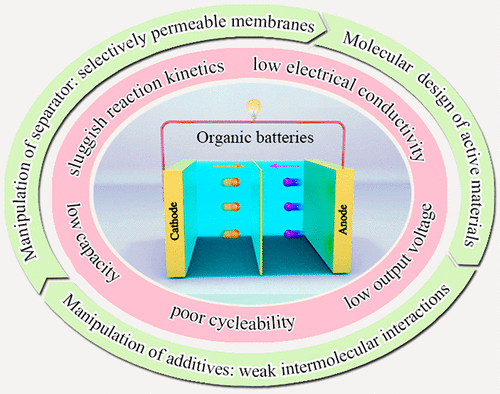当前位置:
X-MOL 学术
›
Acc. Chem. Res.
›
论文详情
Our official English website, www.x-mol.net, welcomes your
feedback! (Note: you will need to create a separate account there.)
Designing High Performance Organic Batteries.
Accounts of Chemical Research ( IF 16.4 ) Pub Date : 2020-09-25 , DOI: 10.1021/acs.accounts.0c00465 Yuan Chen 1 , Chengliang Wang 1
Accounts of Chemical Research ( IF 16.4 ) Pub Date : 2020-09-25 , DOI: 10.1021/acs.accounts.0c00465 Yuan Chen 1 , Chengliang Wang 1
Affiliation

|
Redox active organic and polymeric materials have witnessed the rapid development and commercialization of lithium-ion batteries (LIBs) over the last century and the increasing interest in developing various alternatives to LIBs in the past 30 years. As a kind of potential alternative, organic and polymeric materials have the advantages of flexibility, tunable performance through molecular design, potentially high specific capacity, vast natural resources, and recyclability. However, until now, only a handful inorganic materials have been adopted as electrodes in commercialized LIBs. Although the development of carbonyl-based materials revived organic batteries and stimulated plentiful organic materials for batteries in the past 10 years due to their high theoretical capacities and long-term cycleabilities compared with their pioneers (e.g., conducting polymers), organic batteries are still facing many challenges. For example, it is still essential to enhance the theoretical and experimental capacities of organic materials. Moreover, typically, organic materials suffer relatively low conductivity, which limits their rate capability. In addition, many organic materials, especially small molecules, show poor cycling stability because of their dissolution in organic electrolytes. Other requirements, such as high voltage output and low cost, are also crucial for organic batteries. Therefore, insights into fundamentals (e.g., intramolecular and intermolecular interactions) for a deep understanding of organic batteries and constructive strategies ranging from material design to manipulation of other components (e.g., conductive additives, binders, electrolytes, and separators through controlling the intramolecular and intermolecular interactions and manipulating the ionic transport) are of great significance to boost the performance of organic batteries.
中文翻译:

设计高性能有机电池。
氧化还原活性有机和聚合物材料见证了上个世纪锂离子电池(LIB)的快速开发和商业化,并且在过去30年中,人们对开发各种替代LIB的兴趣日益浓厚。作为一种潜在的替代方法,有机和聚合物材料具有灵活性,通过分子设计可调节的性能,潜在的高比容量,巨大的自然资源和可回收性等优点。然而,到目前为止,在商业化的LIB中仅采用极少数的无机材料作为电极。尽管由于羰基材料的开发具有较高的理论能力和长期循环能力,但在过去的十年中,有机基电池的发展使有机电池复苏,并刺激了用于电池的大量有机材料的使用(例如,导电聚合物),有机电池仍面临许多挑战。例如,仍然必须提高有机材料的理论和实验能力。而且,通常,有机材料具有相对较低的电导率,这限制了它们的速率能力。另外,许多有机材料,特别是小分子,由于它们溶解在有机电解质中而显示出差的循环稳定性。其他要求,例如高电压输出和低成本,对于有机电池也至关重要。因此,您需要深入了解基本原理(例如分子内和分子间的相互作用),以深入了解有机电池以及从材料设计到其他成分(例如导电添加剂,粘合剂,电解质,
更新日期:2020-11-17
中文翻译:

设计高性能有机电池。
氧化还原活性有机和聚合物材料见证了上个世纪锂离子电池(LIB)的快速开发和商业化,并且在过去30年中,人们对开发各种替代LIB的兴趣日益浓厚。作为一种潜在的替代方法,有机和聚合物材料具有灵活性,通过分子设计可调节的性能,潜在的高比容量,巨大的自然资源和可回收性等优点。然而,到目前为止,在商业化的LIB中仅采用极少数的无机材料作为电极。尽管由于羰基材料的开发具有较高的理论能力和长期循环能力,但在过去的十年中,有机基电池的发展使有机电池复苏,并刺激了用于电池的大量有机材料的使用(例如,导电聚合物),有机电池仍面临许多挑战。例如,仍然必须提高有机材料的理论和实验能力。而且,通常,有机材料具有相对较低的电导率,这限制了它们的速率能力。另外,许多有机材料,特别是小分子,由于它们溶解在有机电解质中而显示出差的循环稳定性。其他要求,例如高电压输出和低成本,对于有机电池也至关重要。因此,您需要深入了解基本原理(例如分子内和分子间的相互作用),以深入了解有机电池以及从材料设计到其他成分(例如导电添加剂,粘合剂,电解质,











































 京公网安备 11010802027423号
京公网安备 11010802027423号